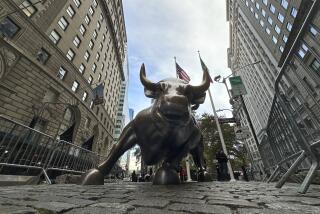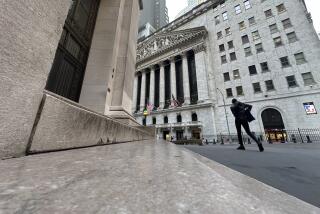FINANCIAL MARKETS AND THE GULF WAR : STOCKS : Dow’s Point Gain 2nd-Biggest Ever
Hopes that the Persian Gulf War would be brief sent Wall Street stocks soaring Thursday.
The Dow Jones industrial average closed up 114.60, or 4.6%, at 2,623.51. It was the second-biggest daily point gain ever, topped only by a 186.84-point gain Oct. 21, 1987.
However, Thursday’s percentage gain was well below the Dow’s biggest historical percentage gains. The Dow leaped 10.2% on Oct. 21, 1987.
Also, the Dow performed far better than most other U.S. indexes Thursday, suggesting that investors were approaching the market with more caution than the Dow gain would indicate. The New York Stock Exchange composite index was up 3.5%, and the NASDAQ over-the-counter composite gained just 2.9%.
Still, winning issues overwhelmed losers on the NYSE, with 1,517 up, 255 down and 254 unchanged. And Big Board volume soared to 318.89 million shares, the eighth-largest total on record at the exchange.
Wall Street’s gains followed huge market advances in the Far East and Europe:
* Tokyo’s Nikkei index soared 1,004.11, or 4.5%, to 23,446.81 on Thursday.
* In Frankfurt, the DAX index jumped 99.99 points, a record 7.6%, to 1.422.67.
“It looks like the victory is going to be quick and relatively painless,” said Robert Walberg, equity analyst at MMS International.
News that U.S.-led forces mounted a massive air strike against Iraq and met little resistance raised hopes that the war would be short. That deflated oil prices and calmed growing fears that the economic recession would continue to deepen.
The market, which opened at 9:30 a.m. EST, went almost straight up at the start. By 10:15, the Dow was already up 94 points.
A circuit breaker limiting some forms of computerized program trading kicked in when the Dow crossed the 95-point-gain mark. That helped keep the market relatively calm the rest of the day. But traders also said buying in general was orderly, not panicked.
The gains were driven in part by “short” sellers buying to cover their positions, traders said. Short sellers have sold borrowed stock in recent months, betting that prices would continue to drop.
“It’s a welcome rally, and I think investors should view the future with somewhat more confidence,” said Michael Ducar, director of research at IDS Equity Advisors.
But analysts also cautioned that the rally may not be sustainable. Indeed, news of an Iraqi missile attack on Israel last night sent Asian markets into turmoil, at least initially.
The Nikkei index, up 400 points early today before news of the attack on Israel, dropped to a loss, then rebounded to a gain of 555.24, to 24,002.05, in afternoon trading. Other Asian markets also dipped on the news from Israel but were rising again as trading wore on and the damage to Israel appeared to be minor.
Among the U.S. market highlights Thursday:
* Many buyers stayed with high-quality names, believing that the financially strongest companies would be the best performers in any market recovery coming out of a recession. Boeing climbed 2 5/8 to 48, Philip Morris rose 2 3/8 to 52 1/8, Pepsico jumped 2 7/8 to 27 3/4. ( Dow stock leaders, chart, D3. )
* Airlines, big fuel users, rose as oil prices plunged. UAL gained 9 to 124, AMR advanced 4 3/8 to 51 1/2, Delta jumped 4 3/4 to 65 5/8 and Southwest rose 1 3/4 to 20 1/2.
* Some defense stocks roared. General Dynamics was up 2 1/4 to 23 3/8, Lockheed rose 1 1/8 to 34 7/8 and McDonnell Douglas added 1 3/4 to 28 3/4. But Raytheon fell 1 1/4 to 68 1/2.
* Retailers were strong on expectations that consumer confidence will quickly return. Dillard soared 3 1/8 to 93 1/8, Mercantile Stores jumped 2 7/8 to 31 1/2, Wal-Mart leaped 2 to 31 7/8 and Gap Inc. was up 3 1/8 to 41 5/8.
* Many high-tech stocks rose as IBM reported better-than-expected earnings. IBM jumped 6 5/8 to 115 3/4, AST Research rose 2 5/8 to 40, Teradata was up 1 to 12 1/4 and Compaq zoomed 3 1/4 to 63.
* Oil stocks were mixed. Arco fell 2 3/4 to 117 1/4, but Exxon rose 1 1/8 to 50 7/8 and Mobil rose 1 3/4 to 58 1/4.
* Gold stocks were pummelled. Newmont Gold fell 4 to 36 1/2, ASA Ltd. lost 4 to 43 1/8 and Echo Bay Mines lost 1 to 8 1/4.
CREDIT Bond Price Jump Is Biggest in 2 Years Investors rushed into bonds to lock in yields on news of the start of the war with Iraq.
The price of the Treasury’s 30-year bond rose 2 3/8 point, or $23.75 per $1,000 in face amount. Its yield plummeted to 8.19% from 8.40% Wednesday.
The last time the long bond price jumped that much in one day was Dec. 6, 1988, when it rose 2-23/32 point as Soviet President Mikhail Gorbachev visited New York, said Kathy Camilli, chief economist at Maria Ramirez Capital Consultants.
Economists and bond traders attributed the jump to the apparent success of the U.S.-led attack.
“I think people by and large were expecting that the initial news about any war would be bad or would do more damage to oil prices. When that didn’t happen, the bond market rallied,” said Nancy Vanden Houten, a money market economist at Merrill Lynch & Co.
Bond investors are keenly concerned about a jump in oil prices, which can signal a rise in inflation. Inflation is especially damaging to the value of fixed-return securities such as bonds.
Traders said it appeared that investors who had converted much of their holdings into cash or Treasury bills in recent months out of uncertainty over the Iraqi standoff returned to U.S. government bonds, expecting interest rates to fall in coming months. The optimism was fueled by belief that oil prices will continue to fall, calming inflation worries.
In the secondary market for Treasury bonds, short-term maturities were up 1-16 point to 1/2 point, intermediate maturities rose 13-16 point to 1 27-32 point, and long-term issues were up as much as 2 7-16 point, according to Telerate Inc., a financial information service.
The movement of a point is equivalent to a change of $10 in the price of a bond with a $1,000 face value.
The Lehman Brothers Daily Treasury Bond Index, which measures price movements on all outstanding Treasury issues with maturities of a year or longer, rose 9.10 to 1,186.81.
The federal funds rate, the interest on overnight loans between banks, fell to 6.25% from 6.688% late Wednesday.
CURRENCY Hopes of Short War Depress the Dollar The dollar fell sharply as the financial markets grew confident that the Middle East war would be short-lived.
The dollar fell nearly 4 pfennigs against the German mark, nearly 2 cents against the British pound and more than 4 Japanese yen.
The U.S. currency surged initially in Asia on Wednesday night on news that the allied air strike had begun.
But the dollar quickly retreated and continued to fall as the markets began to hear of the success of the U.S.-led missions.
Investors consider the dollar to be a safe haven during times of international strife, and the currency had been bid higher in recent sessions in anticipation of Persian Gulf fighting. But Thursday’s belief that the war would be brief sapped their recent strength.
Without the war to bolster the dollar as a safe haven, the market was free to once again consider the weak U.S. economy and the possibility that the Federal Reserve might nudge interest rates lower. The dollar, like all currencies, is supported by higher interest rates, and if yields fall, the dollar tends to follow suit.
The dollar closed at 1.508 German marks in New York on Thursday, down from 1.546 Wednesday. Against the yen, the dollar fell to 132.30 from 136.83.
In Asian trading today, the dollar gained only marginally, to 133.55 yen, on news that the war had expanded to Israel.
COMMODITIES Gold, Silver Prices Take a Steep Dive Precious metals plunged dramatically after the outbreak of war in the Persian Gulf, with the initial reports of success turning what was to be a bullish event bearish.
Gold for February delivery plunged $30.10 on New York’s Commodity Exchange, to $374.40 an ounce, as President Bush called the initial phase of the Persian Gulf war a success. It was one of the largest one-day declines in gold prices in the market’s history.
Silver futures were 18.9 to 21.5 cents lower, with March at $4.040 an ounce.
But early today the metals prices were rebounding in Asian trading, after Iraq struck at Israel. Gold was trading at $386 in Asia at midday.
Grain and soybean futures prices were higher in active trading on the Chicago Board of Trade.
Leading the charge on the Board of Trade were soybeans, which gained on news of dry weather in soybean-producing areas of Brazil, said Rich Feltes, an analyst with Refco Inc. in Chicago.
Analysts also said that the decline in energy prices could head off a severe U.S. recession and allow for increased consumption.
Feltes said the market showed independent strength that may categorize trading in coming months.
“This is a market that displayed it is trading fundamentals,” he said, adding that the market was somewhat divorced from developments in the Persian Gulf.
Feltes said there also was a belief in the market that if hostilities end quickly, there would be a marked movement of food into the Middle East to make up for the economic embargo of Iraq.
Wheat was 2 1/2 cents to 4 1/2 cents higher, with March at $2.54 a bushel; corn was 1 cent to 2 cents higher, with March at $2.40 1/4 a bushel; oats were 1/2 cent to 1 1/4 cents higher, with March at $1.15 1/2 a bushel.
Market Roundup, D6
More to Read
Inside the business of entertainment
The Wide Shot brings you news, analysis and insights on everything from streaming wars to production — and what it all means for the future.
You may occasionally receive promotional content from the Los Angeles Times.










